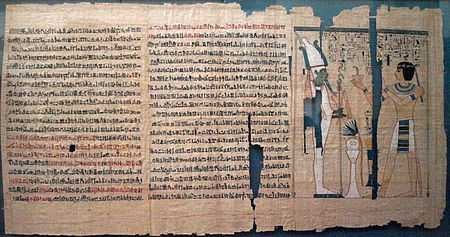High Priests of Amun
| |||||||
| High Priest of Amun Hm nTr tp n imn in hieroglyphs |
|---|
The High Priest of Amun or First Prophet of Amun (hem netjer en tepy) was the highest-ranking priest in the priesthood of the Ancient Egyptian god Amun.[1] The first high priests of Amun appear in the New Kingdom, at the beginning of the Eighteenth Dynasty.
History
The priesthood of Amun rose in power during the early Eighteenth dynasty through significant tributes to the god Amun by ruler such as Hatshepsut and more importantly Thutmose III.[2] The Amun priesthood in Thebes had four high-ranking priests:[3]
- The high priest of Amun at Karnak (hm netjer tepy en Amun), also referred to as the first prophet of Amun.
- The second priest of Amun at Karnak (hm netjer sen-nu en Amun), also referred to as the second prophet of Amun.
- The third priest of Amun at Karnak (hm netjer khemet-nu en Amun), also referred to as the third prophet of Amun.
- The fourth priest of Amun at Karnak (hm netjer fed-nu en Amun), also referred to as the fourth prophet of Amun.
The power of the Amun priesthood was temporarily curtailed during the Amarna period. A high priest named Maya is recorded in year 4 of Akhenaten. Akhenaten has the name of Amun removed from monuments during his reign (as well as the names of several other deities). After Akhenaten's death Amun is restored to his place of prominence among the cults in Egypt. The young pharaoh Tutankhaten changes his name to Tutankhamen to signal the restoration of the old god to his former place of prominence.[4]
The High Priest of Amun in Thebes was appointed by the King. It was not uncommon for the position to be held by dignitaries who held additional posts in the pharaoh's administration. Several of the high priests from the time of Ramesses II also served as Vizier.[5]
At the end of the New Kingdom, the 20th dynasty priesthood of Amun is for a large part dominated by Ramessesnakht. His son Amenhotep eventually succeeded his father and found himself in conflict with the Vicreoy of Kush, Panehesy. Panehesy took his troops North and besieged Thebes. After this period generals by the name of Herihor and Pianchi served as High Priest.

By the time Herihor was proclaimed as the first ruling High Priest of Amun in 1080 BC—in the 19th Year of Ramesses XI—the Amun priesthood exercised an effective stranglehold on Egypt's economy. The Amun priests owned two-thirds of all the temple lands in Egypt and 90 percent of her ships plus many other resources.[6] Consequently, the Amun priests were as powerful as Pharaoh, if not more so. The High Priests of Amun at Thebes from the 21st dynasty were of such power and influence that they were effectively the rulers of Upper Egypt from 1080 to c.943 BC. They are however not regarded as a ruling dynasty with pharaonic prerogatives, and after this period the influence of the Amun priesthood declined. One of the sons of the High Priest, Pinedjem I, would eventually assume the throne and rule Egypt for almost half-a-decade as pharaoh Psusennes I while the Theban High Priest Psusennes III would take the throne as king Psusennes II—the final ruler of the 21st Dynasty.
Notable High Priests of Amun from Thebes
New Kingdom
| High Priests | Pharaoh | Dynasty |
|---|---|---|
| Thuty Minmontu | Ahmose I | 18th Dynasty |
| Hapuseneb | Hatshepsut | 18th Dynasty |
| Menkheperraseneb I Menkheperreseneb II | Thutmose III | 18th Dynasty |
| Amenemhat Mery | Amenhotep II | 18th Dynasty |
| Ptahmose Meryptah | Amenhotep III | 18th Dynasty |
| Maya | Akhenaten | 18th Dynasty |
| Parennefer called Wennefer | Tutankhamen Horemheb | 18th Dynasty |
| Nebneteru Tenry | Sety I | 19th Dynasty |
| Nebwenenef Hori Paser Bakenkhonsu | Ramesses II | 19th Dynasty |
| Roma-Rui | Ramesses II, Merenptah and Seti II | 19th Dynasty |
| Bakenkhons II | Sethnakht Ramesses III | 20th Dynasty |
| Ramessesnakht | Ramesses IV - Ramesses IX | 20th Dynasty |
| Amenhotep | Ramses IX - XI | 20th Dynasty |
21st dynasty and later
- Theban High Priests of Amun (21st and 22nd Dynasty)
- Twenty-first dynasty of Egypt Family Tree
- Twenty-first dynasty of Egypt

25th Dynasty
- Haremakhet, Son of Shabaka 704?-660 BC
- Harkhebi, Son of Haremakhet, Grandson of Shabaka. Served as HPA until at least year 14 of Psamtik I. 660-644 BC
[ 2 unattested HPA or vacant? 644-595]
- Ankhnesneferibre, The God's Wife of Amun also served as High Priest of Amun. 595-560 BC
- Nitokris II, Daughter of Pharaoh Ahmose (II). 560-550?
References
- ↑ Dodson and Hilton: The Complete Royal Families of Ancient Egypt, London 2004
- ↑ Breasted, Ancient Records of Egypt, vol. 2: The Eighteenth Dynasty
- ↑ Dodson, Hilton, The Complete Royal Families of Ancient Egypt, 2004
- ↑ Aldred, Akhenaten: King of Egypt, Thames & Hudson (1991)
- ↑ Kitchen, Rammeside Inscriptions, Translated & Annotated, Translations, Volume III, Blackwell Publishers, 1996
- ↑ Peter Clayton, Chronicle of the Pharaohs, Thames & Hudson Ltd., 1994. p.175
| ||||||||||||||